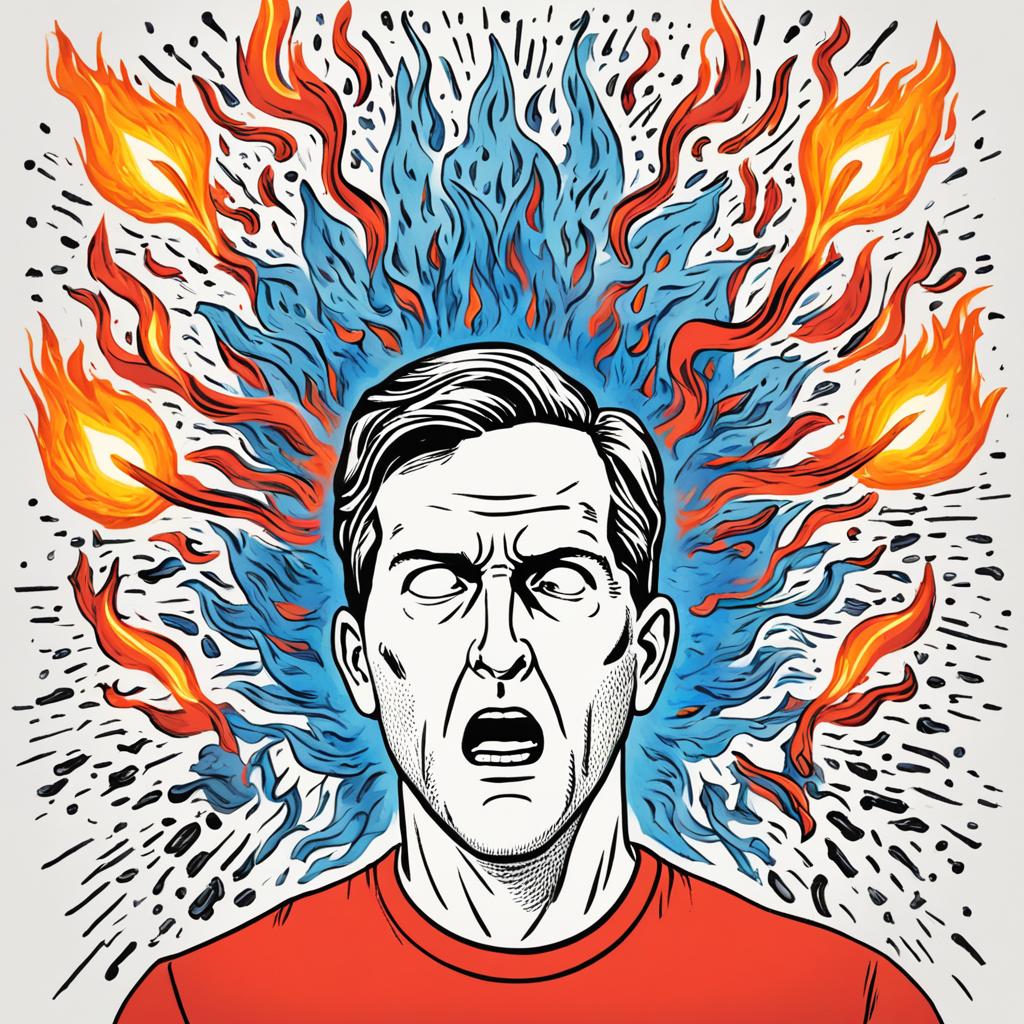Did you know that fear and anxiety affect an estimated 284 million people worldwide? Understanding fear and its impact on our mental health is crucial for managing anxiety and promoting overall well-being. In this article, we will delve into the psychology of fear, explore its causes, examine the brain’s role in fear processing, and discuss effective strategies for overcoming fear. Whether you’re seeking to better understand your own fears or supporting someone who experiences anxiety, this article will provide valuable insights and practical tips for navigating the complexities of fear.
What is Fear?
Fear is a complex emotion that plays a crucial role in our lives. It is a natural response to perceived threats or danger, triggering a cascade of physiological and emotional reactions. Understanding fear and its impact on our mental and physical well-being is essential for navigating the challenges it presents.
The fear response is characterized by a surge of adrenaline, increased heart rate, heightened senses, and a sense of dread. These physiological changes prepare us for the fight-or-flight response, enabling us to react swiftly in the face of danger.
It is important to differentiate fear from anxiety, as the two are often used interchangeably but possess distinct characteristics. While fear is a response to an immediate threat or danger, anxiety is a more pervasive feeling of unease or worry about future events or uncertainties.
“Fear is like fire. It can warm us or burn us. It’s up to us to decide how we handle it.”
By recognizing the differences between fear and anxiety, we can better understand our emotional experiences and develop effective strategies for managing them. In the following sections, we will explore the causes of fear, the role of the amygdala, the various types of fear disorders, and practical techniques for overcoming fear and promoting mental well-being.
Causes of Fear
Fear is a complex emotion that can be triggered by various factors. Understanding the origins of fear is crucial in unraveling its depth and impact on our daily lives. Let’s explore two primary causes of fear: evolutionary factors and learned responses.
Evolutionary Fear
Evolutionary fear refers to the innate fear responses that have been hardwired into our brains over thousands of years of human evolution. These fears have developed as a means of survival, helping us detect threats and respond to them effectively.
For example, the fear of heights, known as acrophobia, can be attributed to our ancestors’ need to avoid dangerous situations that could lead to injury or death. This fear response allowed them to navigate their environment safely.
Learned Fear
Unlike evolutionary fear, learned fear is acquired through personal experiences or observations of others. Through interactions, we learn to associate certain stimuli or situations with fear and develop conditioned responses.
An illustrative example of learned fear is the fear of dogs. If someone had a traumatic experience involving a dog in their childhood, it may result in a fear response every time they encounter a dog in the future. These learned associations can be powerful and long-lasting.
“Fear is not a disease of the mind; it is a learned response to stimuli that over time becomes involuntary.” – Daniel Goleman
Both evolutionary fear and learned fear play significant roles in shaping our responses to different situations. By recognizing the origins of fear, we can better understand why certain things trigger fear in us and how it influences our behavior.


- Evolutionary fear is innate and has been passed down through generations as a survival mechanism.
- Learned fear is acquired through personal experiences and observations of others.
The Role of the Amygdala
When it comes to fear, the amygdala plays a crucial role in our brain’s processing and response. As a key component of the limbic system, the amygdala is responsible for detecting potential threats, triggering the fear response, and influencing our emotional experiences.
Located deep within the brain’s temporal lobes, the amygdala acts as a sort of “fear center”, continuously scanning our environment for any signs of danger. It processes sensory information from our surroundings, including visual and auditory cues, to assess whether a situation poses a potential threat.
Once the amygdala detects a potential threat, it rapidly sends signals to various parts of the brain, triggering the fear response. This response involves a complex interplay between the amygdala, the hypothalamus, and the autonomic nervous system, leading to physiological changes like increased heart rate, heightened senses, and the release of stress hormones.
Moreover, the amygdala not only plays a role in the initial fear response but also in fear conditioning and memory consolidation. It helps us associate certain stimuli or situations with fear, creating long-lasting memories that influence future responses to similar stimuli.
Understanding the role of the amygdala in fear processing is essential for comprehending the complexities of our emotional experiences. By studying the amygdala’s function, researchers can gain insights into fear-related disorders and develop targeted interventions to help individuals effectively manage their fears and anxieties.
“The amygdala is like the brain’s alarm system, constantly on high alert for potential threats. Its intricate network of connections and its involvement in fear conditioning make it a critical component in understanding how fear is processed in the brain.” – Dr. Sarah Johnson, Neuroscientist
To further illustrate the significance of the amygdala in fear processing, consider the following examples:
- When you encounter a snake in the wild, your amygdala quickly recognizes it as a potential threat, triggering the fear response that compels you to either fight or flee.
- A traumatic event, such as a car accident, can leave a lasting impact on the amygdala’s fear conditioning process. This can result in heightened fear responses when encountering similar situations in the future.
The amygdala’s involvement in fear processing underscores the importance of addressing and managing fears through various therapeutic approaches. Understanding how the amygdala functions provides a foundation for developing effective strategies to overcome fear-related challenges and improve mental well-being.


Types of Fear Disorders
In this section, we will explore various fear disorders that individuals may experience, including phobias, panic disorder, and generalized anxiety disorder. These fear-related mental health conditions can have a significant impact on a person’s daily life and overall well-being.
Phobias
Phobias are intense and irrational fears of specific objects, situations, or activities. Common phobias include fear of heights (acrophobia), fear of flying (aviophobia), and fear of spiders (arachnophobia). People with phobias may experience extreme anxiety, panic attacks, and avoidance behaviors when confronted with their phobic stimulus.
Panic Disorder
Panic disorder is characterized by recurrent and unpredictable panic attacks. These attacks are intense, typically reaching their peak within minutes and causing physical symptoms such as rapid heart rate, shortness of breath, and chest pain. People with panic disorder often live in constant fear of experiencing another panic attack, which can significantly impact their quality of life.
Generalized Anxiety Disorder (GAD)
Generalized anxiety disorder is a chronic condition characterized by excessive and uncontrollable worry about various aspects of life, such as work, health, or relationships. People with GAD often struggle with persistent anxiety, even when there is no specific trigger. They may experience physical symptoms, such as muscle tension, fatigue, and difficulty concentrating.


These fear disorders can have profound effects on individuals’ emotional well-being and daily functioning. It’s essential to recognize and understand the symptoms associated with each disorder, as well as the available treatment options.
The Cognitive Aspect of Fear
In addition to the physiological and emotional responses triggered by fear, our thoughts and beliefs play a significant role in shaping our experience of fear. This cognitive aspect of fear involves how we perceive and interpret threatening situations, leading to the development of cognitive distortions.
Cognitive distortions refer to irrational and exaggerated patterns of thinking that can distort our perception of reality. These distortions often contribute to the intensity and persistence of fear. Let’s explore some common cognitive distortions that are often associated with fear:
- Black-and-White Thinking: This cognitive distortion involves seeing things in extreme and polarized terms. It is characterized by rigid thinking and the inability to consider alternative possibilities. In the context of fear, black-and-white thinking can lead to catastrophic thinking, magnifying potential threats and minimizing the likelihood of positive outcomes.
- Overgeneralization: Overgeneralization occurs when we draw broad conclusions based on limited or isolated experiences. In the context of fear, overgeneralization can lead to the belief that a negative event or outcome is a representation of future events. This can instill a sense of fear of the unknown, preventing individuals from taking risks or embracing new experiences.
- Mind Reading: Mind reading is a cognitive distortion that involves assuming we know what others are thinking or feeling without concrete evidence. In the context of fear, mind reading can lead to the belief that others are judging or negatively evaluating us, contributing to social anxiety and fear of rejection.
- Fortune Telling: Fortune telling refers to predicting negative outcomes with certainty, even in the absence of supporting evidence. This cognitive distortion can fuel catastrophic thinking, leading individuals to anticipate the worst possible outcomes and subsequently experiencing heightened fear and anxiety.
- Personalization: Personalization involves assuming that we are responsible for events or situations that are beyond our control. In the context of fear, personalization can lead individuals to blame themselves for perceived threats, intensifying feelings of guilt, shame, and fear.
Challenging and reframing these cognitive distortions is crucial in managing fear and reducing its impact on our well-being. By questioning the accuracy and validity of our fearful thoughts, we can gain a more balanced and realistic perspective of the situation.
Remember, fear is not always a reliable indicator of actual danger. Challenging cognitive distortions allows us to see fear for what it is – a response shaped by our thoughts and beliefs, rather than an objective measure of threat.
One effective strategy for challenging cognitive distortions is cognitive-behavioral therapy (CBT), which helps individuals identify and modify irrational thought patterns. CBT aims to replace distorted thoughts with more rational and adaptive thinking, empowering individuals to face their fears with greater clarity and resilience.


Overcoming Fear
In the journey to overcome fear, there are effective strategies and approaches that can help individuals confront their fears and regain control over their lives. Three such techniques that have proven to be successful are exposure therapy, cognitive-behavioral therapy, and relaxation techniques.
Exposure Therapy
Exposure therapy is a behavioral therapy approach that involves gradually and safely exposing individuals to situations or objects that trigger their fears or anxieties. By facing their fears in a controlled and supportive environment, individuals can learn to reduce their fear responses and develop new coping mechanisms. This therapy aims to help individuals gradually build tolerance to fear-inducing stimuli, leading to decreased anxiety and increased self-confidence.
Cognitive-Behavioral Therapy
Cognitive-behavioral therapy (CBT) is a widely used and evidence-based therapy approach for overcoming fear. It focuses on identifying and changing negative thought patterns and beliefs that contribute to fear and anxiety. Through CBT, individuals can learn to challenge irrational thoughts, replace them with more realistic and positive ones, and develop healthier coping strategies. CBT helps individuals gain a deeper understanding of their fears and empowers them to take control of their thoughts and emotions.
Relaxation Techniques
Relaxation techniques such as deep breathing exercises, meditation, and progressive muscle relaxation can be effective in managing fear and anxiety. These techniques help individuals reduce muscle tension, slow down their breathing, and promote a sense of calm. By practicing relaxation techniques regularly, individuals can develop a greater sense of self-awareness and learn to relax their bodies and minds when faced with fear-inducing situations.
Implementing a combination of exposure therapy, cognitive-behavioral therapy, and relaxation techniques can provide a comprehensive approach to overcoming fear. It is essential to consult with a trained therapist or mental health professional to determine the most suitable combination of strategies for individual needs.


Fear in Daily Life
Fear is a powerful emotion that can significantly impact our daily lives. It often surfaces in common scenarios that evoke feelings of vulnerability and uncertainty. Three of the most prevalent fears that individuals face are the fear of failure, fear of rejection, and fear of change.
The Fear of Failure
The fear of failure can be paralyzing and prevent individuals from pursuing their goals and dreams. It is often rooted in a deep-seated anxiety about not meeting expectations or falling short of personal or societal standards. This fear can hinder personal growth and limit one’s potential. Overcoming the fear of failure requires recognizing that mistakes and setbacks are a natural part of life. Embracing failure as an opportunity to learn and grow can help individuals overcome this fear and move forward with confidence.
The Fear of Rejection
The fear of rejection is a common fear experienced by many individuals. It stems from a fear of not being accepted or valued by others. This fear can lead to self-doubt, social anxiety, and a reluctance to take risks or express oneself authentically. Overcoming the fear of rejection involves building self-confidence, developing healthy boundaries, and reframing rejection as a redirection towards better opportunities and relationships.
The Fear of Change
Change is often accompanied by uncertainty, and for many people, the fear of change can be overwhelming. This fear can manifest as resistance to new experiences, clinging to familiarity, or a fear of the unknown. Overcoming the fear of change requires embracing adaptability and cultivating a growth mindset. Recognizing that change brings opportunities for learning, personal development, and new possibilities can help individuals navigate change with greater ease and confidence.
Fear of failure, fear of rejection, and fear of change can hold us back from reaching our full potential and living fulfilling lives. However, with awareness and the willingness to confront our fears, we can overcome these obstacles and achieve personal growth and success.
The Role of Resilience
Resilience plays a crucial role in managing and coping with fear. When faced with difficult and challenging situations, resilient individuals are able to bounce back and adapt, demonstrating strength in the face of adversity.
Attributes of Resilient Individuals
Resilient individuals possess certain qualities that enable them to navigate fear and overcome obstacles. They have a positive outlook, maintaining hope even in the face of uncertainty. Resilient individuals are also able to regulate their emotions effectively, allowing them to cope with fear in a healthy and productive manner.
“Resilient individuals have the ability to reframe their thoughts, finding meaning and purpose in difficult experiences.”
Moreover, resilient individuals have a strong support system, relying on relationships for guidance, encouragement, and emotional support. This network of support provides a sense of stability and helps them build resilience in the face of fear.
Building Resilience
Fortunately, resilience is not a fixed trait; it can be developed and strengthened over time. Here are some strategies to build resilience:
- Developing strong coping mechanisms: Engaging in activities that promote self-care and well-being, such as exercise, practicing mindfulness, or engaging in hobbies, can help individuals cope with fear and build resilience.
- Practicing positive self-talk: Challenging negative thoughts and adopting a positive mindset can enhance resilience and aid in managing fear.
- Seeking support: Building strong relationships and seeking support from friends, family, or mental health professionals can provide valuable guidance and help individuals navigate fear more effectively.
- Setting goals and taking action: Establishing achievable goals and taking steps towards them can foster a sense of control and resilience, empowering individuals to face their fears head-on.
Resilience and Coping with Fear
Resilience plays a critical role in coping with fear, as it enables individuals to recognize their own strength, adapt to challenging circumstances, and bounce back from setbacks. By building resilience, individuals can develop the skills and mindset necessary to face their fears, manage anxiety, and thrive in the face of adversity.
“Resilience acts as an anchor, providing stability and helping individuals maintain balance amidst the challenges of fear.”
Building resilience is a journey that requires effort and self-reflection. It involves developing a set of skills and strategies that can be applied when facing fear. By fostering resilience, individuals can effectively navigate fear, cope with anxiety, and lead fulfilling lives.
Fear and Self-Care
Fear can have a significant impact on our mental health, triggering anxiety and distress. That is why practicing self-care is vital in managing the anxiety associated with fear. By prioritizing our mental well-being, we can develop resilience and cope effectively with fear.
Self-care practices play a crucial role in nurturing our mental health and overall well-being. Cultivating habits that promote self-care can help reduce anxiety and instill a sense of calmness in the face of fear. Here are some strategies to consider:
- Practice mindfulness: Incorporate mindfulness exercises, such as deep breathing or meditation, into your daily routine. These practices can help ground you in the present moment, easing anxiety and promoting relaxation.
- Engage in physical activity: Regular exercise releases endorphins, which are natural mood boosters. Engaging in activities like walking, jogging, or yoga can help alleviate anxiety and improve overall mental well-being.
- Establish healthy boundaries: Setting boundaries with others and learning to say no when necessary is essential for protecting your emotional well-being. It allows you to prioritize self-care and manage stress effectively.
- Nurture your passions: Pursuing activities you enjoy can provide a sense of fulfillment and serve as a healthy distraction from fear. Engage in hobbies, creative outlets, or any activities that bring you joy.
- Connect with loved ones: Maintaining social connections is vital for mental health. Carve out time to spend with friends and family, whether it’s in-person, over the phone, or through virtual platforms. These connections can provide emotional support and reassurance in times of fear.
“Self-care is not selfish. You cannot serve from an empty vessel.” – Eleanor Brownn
Remember, self-care practices should be tailored to your unique needs and preferences. Experiment with different strategies to find what works best for you. Incorporating self-care into your daily routine can help you manage anxiety, build resilience, and navigate fear more effectively.
Seeking Professional Help
When it comes to fear, seeking professional help can be a crucial step towards understanding and overcoming it. If fear becomes overwhelming or starts interfering with daily functioning, it’s essential to reach out to trained professionals who can provide the necessary support and guidance. Therapists and mental health professionals are equipped with the knowledge and expertise to help individuals navigate their fears and develop strategies for managing them effectively.
There are different types of therapy available that specifically target fear and anxiety. One effective approach is therapy for fear, which focuses on identifying and addressing the root causes of fear and developing coping mechanisms. Therapists utilize various evidence-based techniques and interventions to help individuals gradually confront and overcome their fears, such as exposure therapy and cognitive-behavioral therapy.
Professional support can offer a safe and non-judgmental space to explore our fears, gain insights into our thought patterns, and develop healthier coping strategies. Therapists can guide individuals in challenging negative or irrational thoughts associated with fear and assist in reframing them in a more realistic and empowering way. Through therapy, individuals can learn valuable tools to manage their fears more effectively, improving their overall well-being and quality of life.
Types of Therapy for Fear:
- Cognitive-Behavioral Therapy (CBT) – Focuses on identifying and changing negative thought patterns and behaviors associated with fear.
- Exposure Therapy – Involves gradually exposing individuals to feared situations or objects under controlled conditions to reduce anxiety responses.
- Acceptance and Commitment Therapy (ACT) – Helps individuals learn to accept and manage their fears while aligning their actions with personal values and goals.
Aside from therapy, there are also various mental health resources available for individuals seeking support with fear. Online platforms, helplines, and support groups can provide valuable information, guidance, and a sense of community for those experiencing fear-related challenges. It’s important to remember that seeking professional help and accessing mental health resources is a sign of strength and self-care, enabling individuals to take proactive steps towards improving their mental well-being.
“Seeking professional help is not a sign of weakness, but rather a courageous step towards growth and healing.”
Conclusion
In summary, the psychology of fear is a complex and intriguing subject that sheds light on the intricate workings of our minds. Understanding fear is crucial for recognizing its impact on our mental health and overall well-being. Throughout this article, we have explored the definition of fear, its causes, and the role of the amygdala in fear processing. We have also delved into different fear disorders and examined the cognitive aspect of fear.
Effective anxiety management is a key aspect of maintaining good mental health. From exposure therapy and cognitive-behavioral therapy to relaxation techniques and self-care practices, there are various strategies available to help individuals overcome their fears. Building resilience and seeking professional help are also vital in managing fear and navigating life’s challenges.
It is important to remember that fear is a natural human emotion, but it should not control or limit our lives. By understanding the psychology of fear, seeking support, and implementing effective anxiety management strategies, individuals can develop the resilience and skills necessary to confront their fears and lead fulfilling lives.
